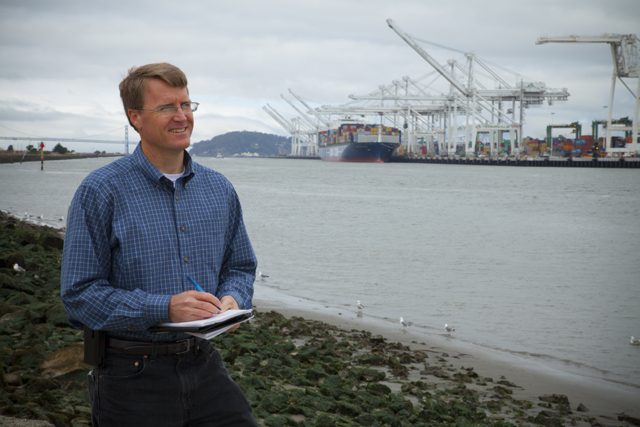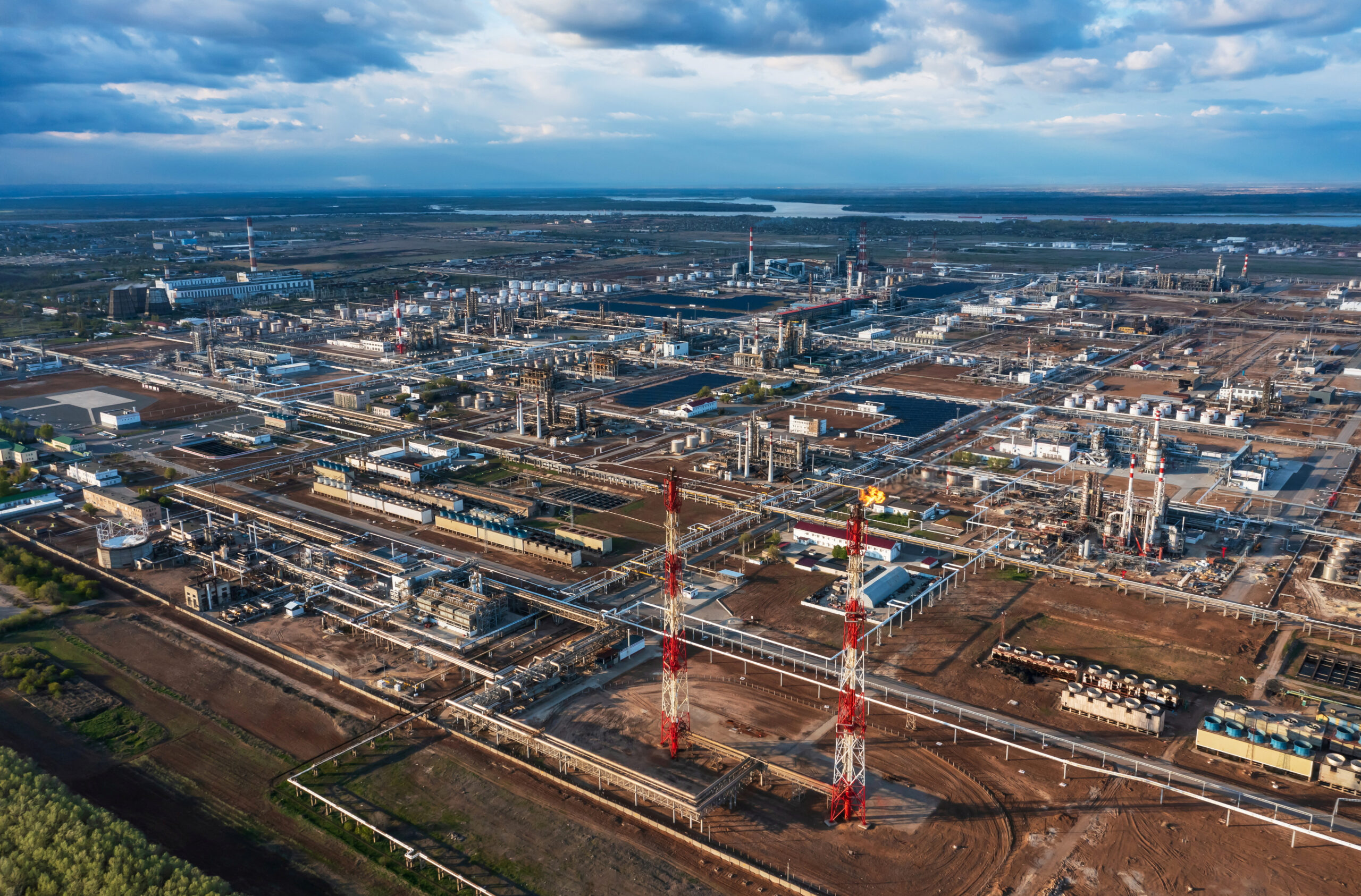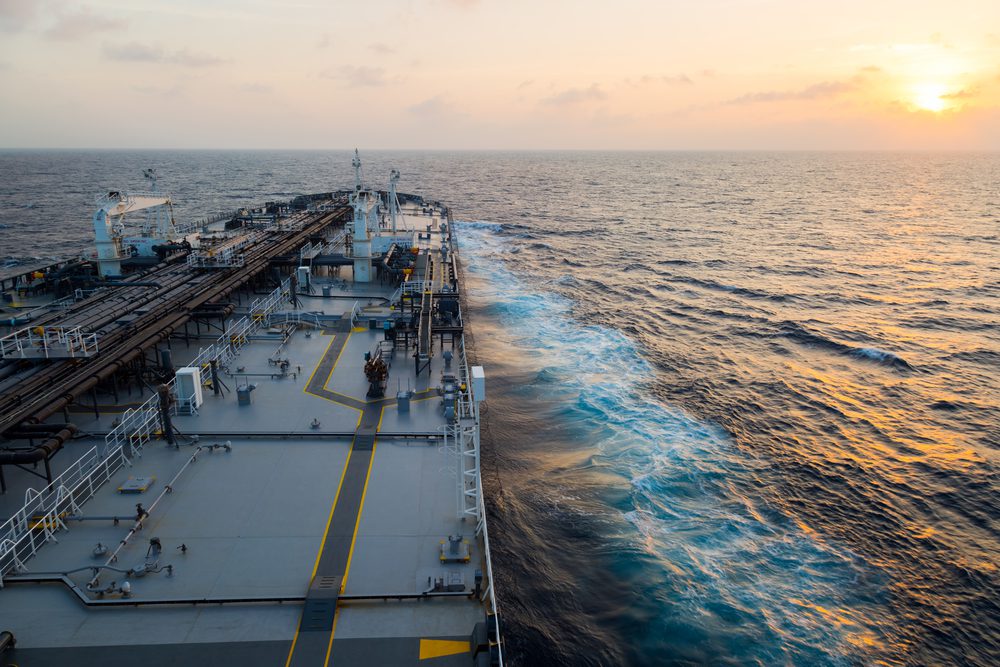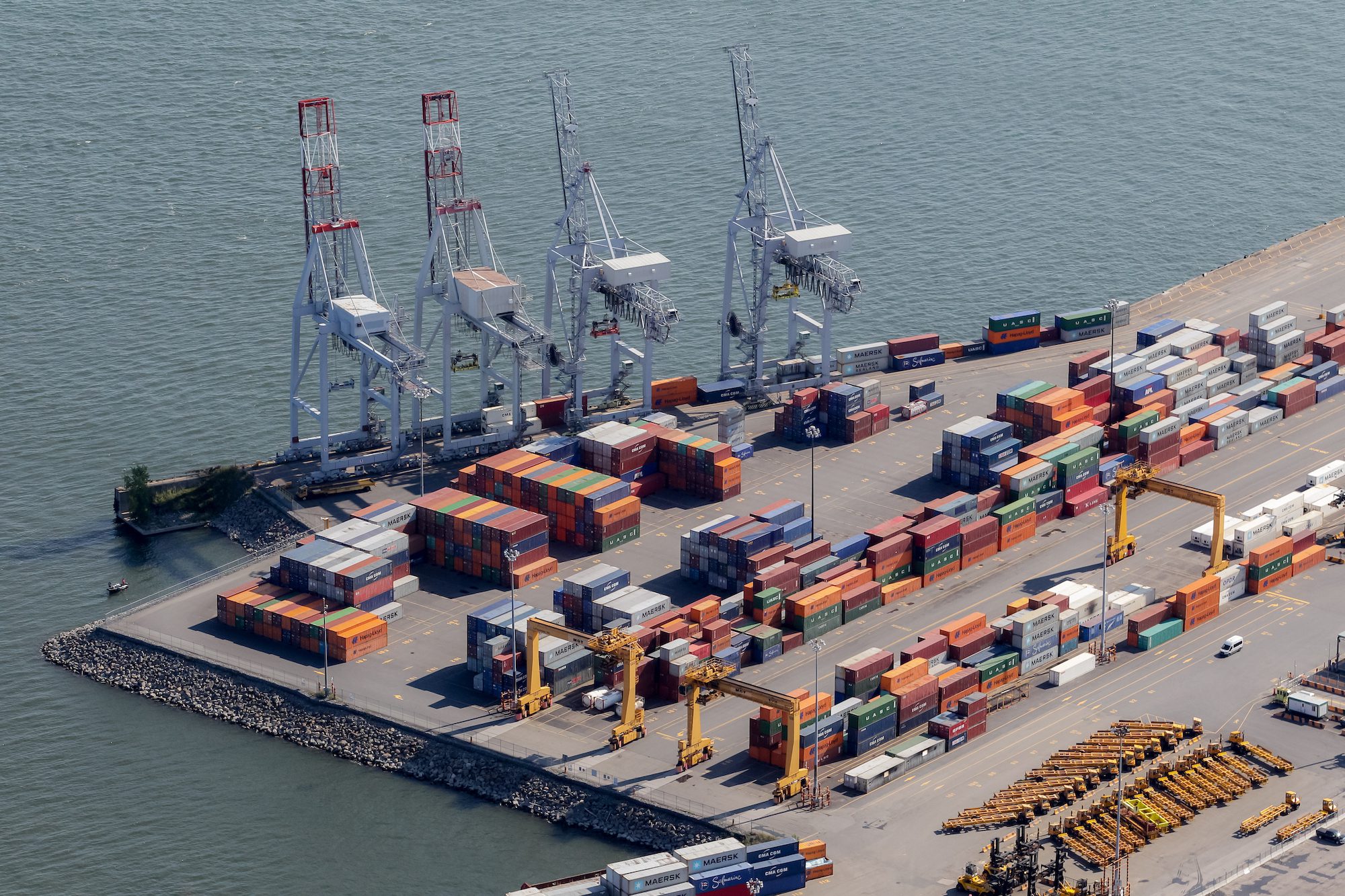Sandia National Laboratories researcher Joe Pratt stands near the Port of Oakland, one of the west coast ports he studied to learn whether hydrogen fuel cells are a viable power source for docked ships. (Photo by Steffan Schulz)
Although most emissions attributed to the maritime sector are released across vast expanses of ocean when a ship is navigating the scarcely populated area amidst their journey between A-B, their emissions are most apparent when ships are berthed in port. Dalsøren et al. (2009) estimate that emissions due to ships’ activities in or around ports account for 5% of total emissions from navigation activities.
Air emissions from port activity have received a great deal of scrutiny in the past decade. In this week’s spotlight, Fathom looks into the world of the port operator and how they are adjusting port infrastructure to support vessel owners and operators to lower the emissions and inherently, fuel consumption of their vessels when in port. We shine the spotlight on not only the developments within the cold ironing marketplace but also an emerging innovative technology solution that could be set to enter the market.
Air Emissions and Port Activity: The Issues
Ships spend a sizeable proportion of time moored in harbours and ports. Merchant vessels, for example, spend around 100 days a year at berth. Most large ships keep their engines idling when they are docked to generate electricity for their onboard living systems. Their auxiliary engines are constantly in operation and they are therefore producing emissions the whole time.
It is estimated that over an eight-hour stay in port, a ship can emit over 2.5 tonnes of pollutants (Source: Climate Institute, 2010). According to 2009 emission data from the Roadmap for Moving Forward with Zero Emission Technologies at the Ports of Long Beach and Los Angeles issued in August 2011, ocean going vessels now account for 43 percent of all nitrogen oxides and 60 percent of all diesel particulate matter from port operations.
Hong Kong considers emissions from berthed cruise and cargo ships to be the biggest cause of its air pollution. According to figures from the Los Angeles Air Quality Management District (AQMD), emissions from berthed ships account for 700 premature deaths every year. In the European Union, international shipping pollution is expected to outstrip land-based sources by 2020.
Port operators and authorities are facing a plethora of pressures from a multitude of stakeholder groups to facilitate reduced emissions of SOx, NOx, CO2 and particulate matter (PM) in their designated port areas and are increasingly looking to adapt their infrastructure, initiatives and best practices in order to do so.
So what can port operators and authorities do?
The Infrastructure Opportunity
There are a number of ways in which ports are supporting the industry in order to reduce vessel emissions, including:
- Communications: As vessels become connected to the global information network via onboard satellite communications, ports can help leverage this additional connectivity by managing arrivals so that if the port is too congested, the vessel knows that it must decrease speed, rather than consume fuel at a more expensive, faster rate, only to then have to continue to consume waiting to dock. Trials undertaken by the Oil Companies International Marine Forum (OCIMF) and Intertanko show that fuel consumption and subsequent CO2 emissions, for example, can be reduced by up to 22%.
- Cold-ironing: or alternative maritime power (AMP), or shore power is the process of providing shoreside electrical power to a ship at berth while its main and auxiliary engines are turned off. Cold ironing permits emergency equipment, refrigeration, cooling, heating, lighting and other equipment to receive continuous electrical power while the ship loads or unloads its cargo.
- LNG: Ports can also further support emissions reduction by investing in the development of LNG infrastructure.
Cold-Ironing: The Future?
Cold-ironing is a practice that has increasingly occupied the headlines across the global shipping trade press for the last decade.
In essence the practice displaces the responsibility for power generation away from the vessel and on to a centralised power source- usually a power station running on fossil fuels that is more energy efficient. Cold-ironing takes the idea of energy savings via integration on an individual operational level and applies it on a macro level.
The auxiliary engines can be switched off and the power required for the vessel’s in-port activities drawn from a shore based source.
Its name is taken from the days of coal fired vessels, when a ship was tied up at port there was no need to continue to feed the fire and the iron engines would literally cool down, eventually going completely cold, hence the term cold-ironing.
In order to allow for cold ironing, marine terminals must be equipped with extra electrical capacity, conduits, and the “plug” infrastructure that will accept power cables from a vessel. A large container ship typically requires approximately 1,600 kilowatts (kW) of power while at berth, but the power requirements can differ substantially, depending on the size of the vessel and the requirements on-board e.g. the number of refrigerated containers on board.
A WCPI survey showed that 32% of ports currently provide shore-side electricity, which initially indicates a limited uptake of the technology; this is especially prevalent within the EU. However, 85% said that they are considering introducing or expanding shore-side power facilities in the next five to ten years.
But what will the future bring for the conversion of infrastructure to facilitate the practice of cold-ironing?
Peter Selway, Marketing Manager, Schneider Electric told Fathom “most enquiries for our cold-ironing solutions come from port operators, however shipping companies are really starting to put pressure on port operators to provide the service of cold-ironing”
To support the growing pressures from the shipping community for cold-ironing infrastructure at ports, Schneider Electric believe that a modular based system that can be built up or reduced according to demand is the way forward. In addition to this, it will be important that systems that are supported by accessible software that supports the hardware showing users exactly what is happening at any given moment. In this way it can provide the flexible operation that reflects the demands of the port operations.
As a company that invests heavily in R&D, they are certainly putting they money where their mouth is when it comes to this emissions and fuel consumption reducing technology solution, Selway stated “We believe that cold-ironing is going to be the way forward for the industry”
Cold-ironing the Benefits and Economics
Schneider Electric explained to Fathom the beneficial areas to all stakeholder groups that their cold-ironing, and in fact cold-ironing as a practice in general can bring:
- Ships: cut operational costs by saving high-cost low-sulphur fuel while berthed.
- Ports: maximise ROI by transforming the investment into a new business opportunity by providing grid power to ships.
- Community and port personnel: Increase wellness and the quality of life by cutting emissions, noise and vibrations.
Gary Buckingham, Customer Marketing Manager, Schneider Electric put the infrastructure demands of cold-ironing into perspective: “ An average house draws 3.3.Kw from the grid, according to the UK power generator regulators Ofgem, whereas a large cruise liner could draw around 20,000Kw”
However, if the infrastructure can be modified to support such pressures of electricity generation, shoreside power is much cheaper than running the ship’s engines whilst in port.
It costs ship owners 25% more to run a diesel generator that to plug into shorepower, and with the pressures that the shipping community faces for purchasing higher priced low sulphur fuel oil, this margin is set to increase” commented Buckingham.
A report, ‘The economics of cold ironing’ released by technical publication Port Technology International, estimated that at USD $1.5 million per berth, with a 30-year design life and 6% interest, shoreside construction costs are USD $110,000 per year per berth. This is for a traditional fixed cold-ironing system, not modular.
It has cost the Port of Oakland, for example, USD $70 million to install 11 berths on six terminals.
The vessels themselves will also have to be retrofitted or built with the necessarily electrical infrastructure: at an estimated USD $400,000 per vessel, with a 20-year life span and 6% interest, the annual cost of the retrofit would work out to USD $170,000 for vessel modifications to a fleet of five vessels. Including retrofitting costs and shoreside infrastructure cost, the total annual construction cost per berth is USD $280,000.
With Marine Diesel Oil (MDO) costs rising, a power station should in theory be able to produce power cheaper per kW/hr. The potential emissions advantage would be maximised if instead of using non-renewable fuels, the centralised power source was generated from clean energies such as hydroelectric or nuclear.
Schneider Electric estimates that based on the average 2011 marine diesel fuel prices of €983/tonne, electricity generated onboard by diesel engines would cost €156/MWh as opposed to €120/MWh for power from the grid.
The aforementioned report published by Port Technology International estimates that if a craft berthing for 24 hours in a Californian port is charged the commercial rate of USD $0.11 per kWh for using 1600kW shore power, it will pay USD $4,200. That’s less than half the price of burning marine diesel oil.
The economic advantages are not simply in terms of fuel consumption. Cold-ironing, for obvious reasons, reduces the engine’s running time, which will lead to reduced maintenance costs and downtime and a longer life cycle. Annual engine maintenance savings per ship have been estimated €9,600 (at maintenance costs of €1.6 per hour per engine).
According to the Port Technology International report, cold-ironing is consistently cheaper even when the worst case cold-ironing economic scenario is compared with the best case conventional scenario – with the exception of Hawaii.
From an Emissions Perspective – Straightforward Reductions?
However, cold-ironing, like any solution, is not without its issues. One key thing to be aware of is that, in some cases cold-ironing will increase emissions. ’The economics of cold ironing’ calculated that as Hawaii generates most of its power with fossil fuels – despite the fact that it has a climate that would make solar and wind very credible alternatives and its abatement technologies are not enough to have an impact: Cold-ironing would have the net result of creating more CO2 emissions.
The solution is therefore not always fit for purpose from an emissions perspective; grid-based power is not always as eco-friendly as assumed. If the overall emissions reduction is small then cold-ironing becomes more of an expensive ‘pass the parcel’ approach rather than a proactive, aggressive strategy to clean up the industry and global emissions.
Future Innovation – Hydrogen Cells
A new study by Sandia National Laboratories on the feasibility of providing auxiliary hydrogen power to docked or anchored ships, has suggested the evolution of alternative future solutions. Sandia are proposing hydrogen cells as a power generation source.
The traditional set-back to cold-ironing has been lack of infrastructure, the investment required and the complexity of the solution.
“A barge-mounted hydrogen-fuelled proton exchange membrane (PEM) fuel cell system has the potential to reduce emissions and fossil fuel use of maritime vessels in and around ports,”The Sandia study stated.
“The conceptual design of the system is found to be straightforward and technically feasible in several configurations corresponding to various power levels and run times. The most technically viable and commercially attractive deployment options were found to be powering container ships at berth at the Port of Tacoma and/or Seattle, powering tugs at anchorage near the Port of Oakland, and powering refrigerated containers on-board Hawaiian inter-island transport barges,” it continued.
Supplying a container ship with average power and run times (1.4 megawatts over 48 hours) requires four 40-ft containers, two for the fuel cell and two for hydrogen fuel storage, whilst less power-intensive vessels – such as tugboats – would only require a single container, Sandia explained.
“You can replace the diesel generator with a hydrogen fuel cell without changing the operations. It’s just a power source in a box, a shipping container in this case,” said Joe Pratt, author of the study.
“A successful deployment of the containerized fuel cell on a floating platform in a typical marine environment will be useful not only in this particular service, but also because it validates the concept for the larger, container-ship-sized application,” he said.
Conclusion
The industry has recognised that long periods in berth, powered by bunker fuel, are no longer feasible and ports are showing an interest in helping the industry to develop alternatives.
Whilst fixed station cold ironing has been one such method, the industry has also been quick to respond to the challenge with more flexible alternatives such as the modular system from Schneider Electric and the proposed hydrogen cell method from Sandia.
Both port authorities and shipping owners can no longer claim not to have viable alternatives to running diesel engines- they already exist!
For more news and tips on efficient shipping, please visit Fathom-cTech

 Join The Club
Join The Club











